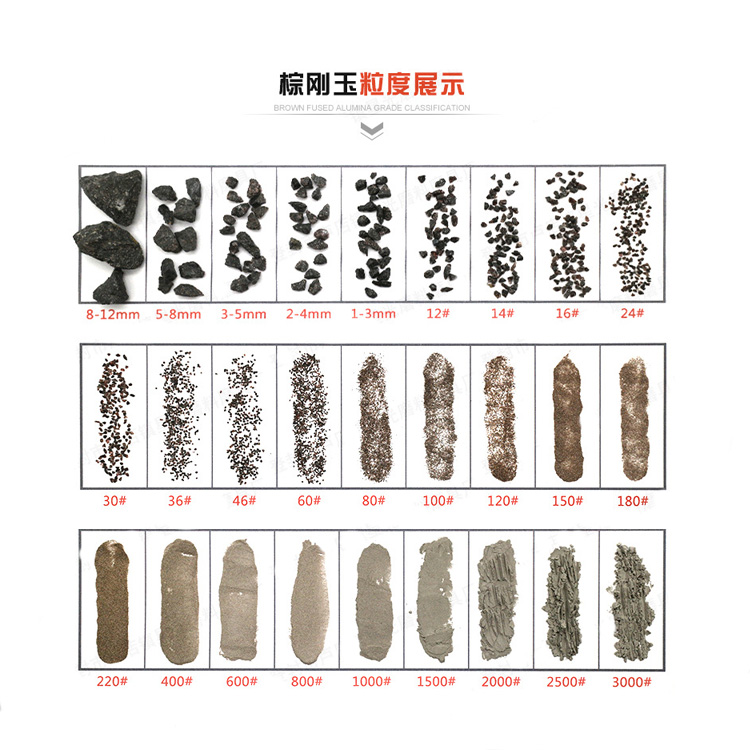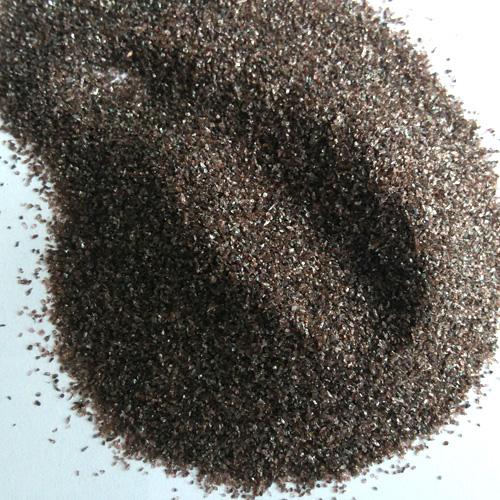
Brown corundum is made of natural bauxite as raw material, carbon (mainly coke) is used as reducing agent, and iron filings are added as sedimentation agent (clarifier) to form ferrosilicon deposited on the bottom of electric furnace.
Brown fused alumina for conventional abrasive
Brown corundum is made of natural bauxite as raw material, carbon (mainly coke) is used as reducing agent, and iron filings are added as sedimentation agent (clarifier) to form ferrosilicon deposited on the bottom of electric furnace.
Brown fused alumina is tan, generally A12O3≥94.5%, SiO2≤3.5%, TiO2≤3.5%, FeO3≤1%. The mineral composition is mainly a-Al2O, the central part of the crystal shape is rhombus, thick plate and cracked particles, and there are many silicon oxide and calcium oxide melt crystals around, which are long plate-like, and the coarsest grains are Skeletal platelets. Due to miscellaneous
The quality has not been completely removed, so brown fused alumina also contains secondary crystalline phases such as rutile, as well as glass phases, iron alloys and solid solutions. The hue of brown corundum depends to a large extent on the titanium oxide remaining in the product.
Brown fused alumina is mainly used as abrasive. In recent years, it has been used as an aggregate for large and medium-sized blast furnace tap ditch castables and anhydrous tap mud, and as a raw material for the manufacture of ordinary corundum bricks (including high-alumina silicon carbide bricks).
|
particle size range |
Al2O3% |
TiO2 |
CaO |
SiO2 |
Fe2O3 |
|
0-1,1-3,3-5mm |
95~97 |
1.7~3.40 |
≤0.42 |
≤1.00 |
≤0.30 |
|
F4~F80 P12~P80 |
95.00~97.00 |
1.70~3.40 |
≤0.42 |
≤1.00 |
≤0.30 |
|
F90~F150 P100~P150 |
94.50~97.00 |
||||
|
F180~F220 P180~P220
|
94.50~97.00 |
1.70~3.60 |
≤0.45 |
≤1.00 |
≤0.30 |
|
F230~F800 (P240~P800)
|
≥93.5 |
1.70~3.80 |
≤0.45 |
≤1.20 |
≤0.30 |
|
F1000~F1200 (P1000~P1200) |
≥93.00 |
≤4.00 |
≤0.50 |
≤1.40 |
≤0.30 |
|
P1500~P2500 |
≥92.5 |
≤4.20 |
≤0.55 |
≤1.60 |
≤0.30 |
|
F4~F80 P12~P80 |
≥94.00 |
1.50~4.00 |
≤0.50 |
≤1.40 |
- |
|
F90~F150 P100~P150 |
≥93.00 |
1.50~4.00 |
≤0.50 |
≤1.40 |
- |
|
F230~F800 (P240~P800)
|
≥92.50 |
≤4.20 |
≤0.60 |
≤1.60 |
- |
|
F1000~F1200 (P1000~P1200) |
≥92.00 |
≤4.20 |
≤0.60 |
≤1.80 |
- |
|
P1500~P2500 |
≥92.00 |
≤4.50 |
≤0.60 |
≤2.00 |
- |

White corundum is made from industrial alumina powder, which is smelted in an arc at a high temperature above 2000 ℃ and then cooled. After crushing and shaping, magnetic separation to remove iron, it is divided into various particle sizes.
Brown Fused Alumia powders are fused wIth premium raw materials and 3500 KVA furnace. It is perfect material specifically manufactured to be used for general abrasive applications in bonded abrasive tools, polishing and sandblasting grit. It has lower hardness and abrasive capacity than diamond, boron carbide, and silicon carbide, it is widely used for grinding ferrous materials, finishing tough and hard materials. It is also be used as high-class refractory materials. Brown Fused Alumia is offered in macro and micro powder form, in both F and P grades.
The chemical composition of bauxite is mainly Al2O3, SiO2, Fe2O3, TO2, accounting for about 95% of the total composition, and the secondary components are CaO, MgO, K2O, Na20, S, MnO2 organic matter and trace components Ga, Ge, etc.
Special Acid-proof Brick Lightweight acid-proof Brick Acid resistant brick is the ideal choose for your project with their features of proof pressure, corrosion resistance, easy to clean and acid-base resistance.
White corundum is made from industrial alumina powder, which is smelted in an arc at a high temperature above 2000 ℃ and then cooled. After crushing and shaping, magnetic separation to remove iron, it is divided into various particle sizes.
Chrome corundum brick refers to corundum refractory products containing Cr2O3. At high temperature, Cr2O3 and Al2O3 form a continuous solid solution, so the high temperature performance of chromium corundum products is better than that of pure corundum products. Chromium corundum products are widely used, and the content of Cr2O3 is mostly in the range of 9% to 15%.
The alkali-resistant brick for cement kiln has the characteristics of strong alkali erosion resistance, good thermal shock resistance and high cost performance.
The high-alumina refractory bricks sold by Yuying refractory manufacturers are commonly used refractory bricks with high thermal stability and refractoriness above 1770°C. It has good slag resistance and is used for the lining of steelmaking electric furnaces, glass melting furnaces, cement rotary furnaces, etc.



